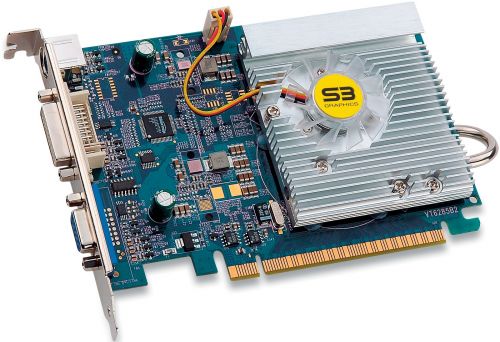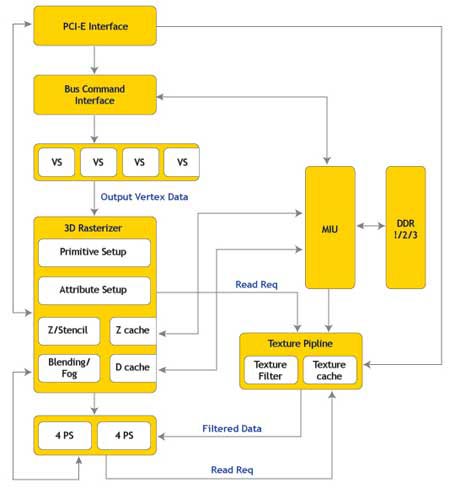S3 Chrome S27 особенности архитектуры
In terms of graphics architecture, the new S3 GPU closely resembles the enhanced Delta/Gamma Chrome, capable of running at very high clock speeds and supporting high-speed GDDR3 memory.

Using Fujitsu's new 0.09µm process technology, S3 Graphics has been able to push the Chrome S27 graphics core to a never-before-seen 700MHz. This is a kind of record in the desktop consumer graphics industry - up to this moment ATI Technologies with its RADEON X1800 XT, whose graphics processor runs at 625 MHz, held the palm.
Of course, just increasing the clock speed of the graphics core is not enough to achieve success, and the company went further: the Chrome S20 line received a new memory controller that supports all existing types of graphics DRAM - from DDR to GDDR3. Also, the volume of caches and the number of registers have been increased. The latter means that Chrome S20 GPUs are now able to execute longer instructions. Of course, we are talking about internal instructions directly executed by the processor - as in the solutions of ATI and NVIDIA, they are delivered to the graphics processor by a software compiler that works at the driver level and translates the source shader code on the fly into the code that is most efficiently executed by that graphics architecture, for which the compiler is optimized. According to S3 Graphics,
All of the above, combined with 8 pixel and 4 vertex processors, as well as GDDR3 memory operating at 700 (1400) MHz, should help the new S3 Graphics achieve good results in its class. Since, architecturally, the novelty is a direct successor of Delta Chrome and Gamma Chrome, support for pixel and vertex shaders is limited to Shader Model 2.0. In fact, the chip, like its predecessors, supports the extended Shader Model 2.0+ specifications (which should not be confused with Shader Model 2.0b), but due to the complete lack of support for these extensions by game developers, this has no practical significance since end user point of view.

Other innovations include support for Chrome S27 S3 MultiChrome technology, which is similar to ATI CrossFire and NVIDIA SLI technologies. Since S3 Graphics is a division of VIA Technologies, the use of MultiChrome is primarily intended for the recently announced VIA K8T900 platform, which supports the "PCI Express x8 + PCI Express x8" formula. According to S3, there are no obstacles to successfully merging two S3 Chrome S27 cards on platforms from other developers, but it is not yet possible to verify this due to the fact that we have only one test sample of this video adapter at our disposal.
Also, the S20 family received a new version of the Chromotion video engine - Chromotion 3.0, which has support for all HDTV standards, including 1080i / p, and some interesting features, one of which is the ability to perform non-linear image scaling when converting a frame with an aspect ratio of 4:3 to a frame of format 16:9. Hardware video decoding in WMV9 format is available, including the WMV HD standard, but the H.264 codec is not supported, so the RADEON X1000 is the only solution capable of hardware decoding the new high-definition format.
Another new technology, AcceleRAM, is supported only by the Chrome S25 processor and is similar to NVIDIA TurboCache and ATI HyperMemory technologies. As you might guess, its essence is to use part of the PC's system memory to store video data. Of course, there are no hardware restrictions on the use of AcceleRAM in Chrome S27, since it is architecturally identical to Chrome S25. However, the Chrome S27 video adapter, being the most productive solution in the new family, initially carries a sufficient amount of video memory on board - 128 or 256MB. Since this review is dedicated specifically to the S3 Chrome S27, we will not go into the details of the functioning of AcceleRAM, we will only note that support for this technology has become possible thanks to a new memory controller - one of the innovations
Specifications S3 Chrome S27
| video processor | Chrome S27 |
| Technical process, microns | 0.09 |
| Number of pixel/vertex pipelines | 8/4 |
| Memory bus width, bit | 128 |
| Shader support | Shader Model 2.0+ |
| Core/memory frequencies, MHz | 700/700 (1400) |
| video memory | 128 MB GDDR3, 1.4 ns |
| Interfaces | DVI, D-sub, S-Video |
The S3 Chrome S27 was quite able to compete on equal terms with the ATI RADEON X1300 PRO, RADEON X700 and GeForce 6600 GDDR2, even if mainly due to high GPU and memory clock speeds.



